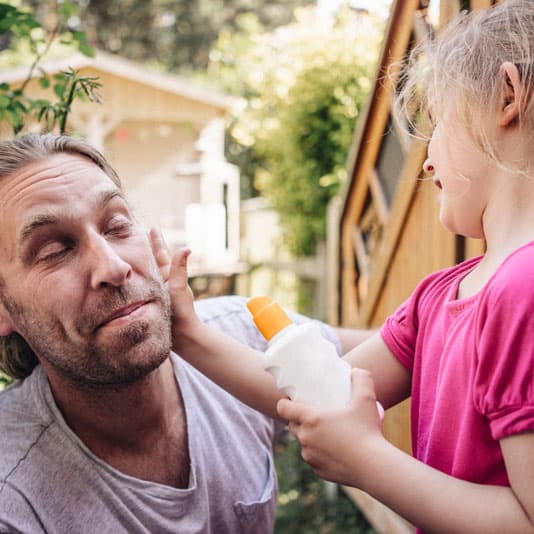Five things you should know about sun safety and your skin
Written by Nick Thompson
Published on 24/7/2023
We wear suncream for three reasons: To reduce the risk of skin cancers like melanoma, prevent burning, and avoid premature ageing in our skin. Prolonged exposure to harmful UV rays without protection can contribute to all of the above, but this isn't a fear-mongering article; it's an advice article. So let's get back to why we're here.
Five things you might not have known about sun protection or alternatively, five facts you can share on holiday to impress your family:
1. The SPF number is how long you're protected for
SPF stands for Sun Protection Factor, and the numbers after SPF is how long the protection lasts. SPF 30 means the sun will take 30 times longer to burn or redden your skin. If it usually takes 10 minutes for you to burn in the sun without suncream, SPF 30 will turn that into around 300 minutes.
The higher the SPF also means the higher the protection against the shorter wave UVB rays that are responsible for burning, with SPF 30 blocking out approximately 97% and SPF 50 blocking out around 98% of rays.

2. SPF isn't the only protection to look for
We mentioned SPF above and what the numbers mean, but that only protects against UVB rays. You also need to think about UVA rays. They are longer wave rays that are associated with premature ageing of the skin. Both UVA and UVB rays are harmful and can damage DNA in skin cells, which can lead to skin cancer.
Most sunscreens protect against UVA rays; look out for sunscreen that either says “broad spectrum” or has a UVA seal on the bottle. The UVA seal is a circle with UVA written above some stars (pictured). The more stars, the higher the protection, and we recommend looking for suncream with four or above.

3. Medication can cause increased sun sensitivity
If you're taking medication, using a new facewash, or have any form of skin routine, check the labels for increased sensitivity to the sun. It may mean you need to use a high SPF or take precautions when outside.
Increased sun sensitivity can cause reactions like swelling or a higher risk of burning and sun damage. Speak to your GP or book an appointment through your Simplyhealth plan for advice and reassurance.
Speak to a GP wherever you are
Video and phone appointments with experienced GPs, that fit your schedule, at home and abroad.
4. Suncream can go out of date
Yes, suncream has an expiry date, and it's worth checking your old bottles before your next trip because the date is there for a reason. The ingredients in suncream can become unstable when past their expiry date, causing a potential loss in effectiveness and ability to protect your skin.
As well as looking at the date, check the consistency, texture, and smell. If it differs from when you purchased the suncream, it's time to head to the shop. If the expiry date has rubbed off and you know you've had the suncream for a while, we recommend getting a new bottle even if the consistency is still the same. It's not worth the risk.
5. Although unlikely, you can get sunburnt through glass and windows
Regular glass filters out 97% of UVB rays, much like SPF 30 suncream, so whilst it's unlikely you'll get burnt through glass, it's not impossible. The risk of burning can also depend on factors like the type of glass, the time of day, and the length of exposure time.
Windscreens on cars provide high protection against UVB rays, but it's still worth wearing suncream, especially on long drives. UV rays can also damage your eyes, much like sunburn damages your skin, so you should wear sunglasses with UV protection to shield your eyes.
Enjoy the outdoors and always protect yourself
If you’re heading out this summer, our advice would be to apply a broad-spectrum suncream liberally to exposed areas of the skin and then reapply every two hours. If you've been swimming, showering, or towelled yourself down, reapply it immediately to get maximum protection against UV rays.
Remember:
Use a high SPF for the best protection
Look for “broad spectrum” or a UVA seal with 4 or more stars.
Check the side effects of medication and any skincare routine
Make sure your suncream is still in-date and effective
Avoid sitting directly in the sun for long periods, even indoors!
If you are concerned about anything related to your skin, whether it’s sunburn and blisters or a mole or unusual mark on your skin, it’s worth getting it checked. You can book an appointment with a GP through your Simplyhealth plan without any additional cost, even when abroad. Head to your online account to get started.
You might also be interested in...

Healthy Living Hub
Our collection of articles and resources focused on your health and well-being,covering topics like women's health, online GP services and more.

Health treatments explained
Find out more about the health treatments covered on our plans, including what's included in the counselling and advice support line service.
This material may contain links to other websites operated by third parties. It is the responsibility of third parties to ensure such material and websites comply with all relevant laws and regulations. To the maximum extent permissible by law Simplyhealth disclaims all responsibility for such websites.